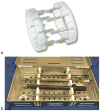Venous Thrombosis in Handsewn versus Coupled Venous Anastomoses in 857 Consecutive Breast Free Flaps
- PMID: 26372685
- PMCID: PMC4787258
- DOI: 10.1055/s-0035-1563737
Venous Thrombosis in Handsewn versus Coupled Venous Anastomoses in 857 Consecutive Breast Free Flaps
Abstract
Background: The anastomotic coupling device has demonstrated safety and efficacy; however, the coupler has never been compared directly to handsewn venous anastomoses exclusively in breast reconstruction. We hypothesized that rates of venous thrombosis would be lower using the coupler versus handsewn anastomoses in free flap breast reconstruction.
Methods: We performed a retrospective review utilizing clinic records, hospital records, and operative reports for 857 consecutive breast free flaps at a single institution from 1997 to 2012. Data were collected on reconstruction type, recipient vessels, timing, laterality, preoperative radiation, chemotherapy, venous thrombosis, and flap outcome. We compared rates of venous thrombosis between handsewn and coupled anastomoses for breast free flaps. Chi-square test was used to calculate statistical significance.
Results: A total of 857 consecutive free flaps were performed for breast reconstruction in 647 patients over 16 years. The venous anastomosis was handsewn in 303 flaps, and the anastomotic coupler was used in 554 flaps. The rate of venous thrombosis requiring anastomotic revision in the handsewn group was 0.04% (12/303), compared with 0.01% in the coupled group (8/554; p = 0.02).
Conclusion: The anastomotic coupler was more effective in preventing venous thrombosis than handsewn anastomoses in our series. While our study demonstrates improved patency rates using the venous coupler in breast reconstruction, we were unable to definitively separate this finding from potential confounding variables due to the low rates of thrombosis in both the groups. Our data are consistent with current literature, which suggests that the coupler is a safe and effective alternative to hand sutured anastomoses.
Thieme Medical Publishers 333 Seventh Avenue, New York, NY 10001, USA.
Figures


Similar articles
-
1000 consecutive venous anastomoses using the microvascular anastomotic coupler in breast reconstruction.Plast Reconstr Surg. 2010 Mar;125(3):792-8. doi: 10.1097/PRS.0b013e3181cb636d. Plast Reconstr Surg. 2010. PMID: 20195107
-
Venous thrombosis in coupled versus sutured microvascular anastomoses.Ann Plast Surg. 2006 Dec;57(6):666-9. doi: 10.1097/01.sap.0000229958.57126.21. Ann Plast Surg. 2006. PMID: 17122555
-
Venous anastomoses using microvascular coupler in free flap head and neck reconstruction.J Oral Maxillofac Surg. 2012 Apr;70(4):992-6. doi: 10.1016/j.joms.2011.02.111. Epub 2011 Jul 13. J Oral Maxillofac Surg. 2012. PMID: 21741742
-
Economic Comparison of Hand-Sutured and Coupler-Assisted Microvascular Anastomoses.J Reconstr Microsurg. 2018 Jan;34(1):71-76. doi: 10.1055/s-0037-1606540. Epub 2017 Sep 25. J Reconstr Microsurg. 2018. PMID: 28946154 Review.
-
Unique Complications of Venous Anastomotic Couplers: A Systematic Review of the Literature.J Reconstr Microsurg. 2020 Jul;36(6):403-411. doi: 10.1055/s-0040-1702151. Epub 2020 Feb 27. J Reconstr Microsurg. 2020. PMID: 32106314
Cited by
-
Protocol for a systematic review of venous coupler devices versus hand-sewn anastomosis for microsurgical free flap reconstruction.Syst Rev. 2018 Nov 13;7(1):186. doi: 10.1186/s13643-018-0871-x. Syst Rev. 2018. PMID: 30424802 Free PMC article.
-
Towards standardization of training and practice of reconstructive microsurgery: an evidence-based recommendation for anastomosis thrombosis prophylaxis.Eur J Plast Surg. 2018;41(4):379-386. doi: 10.1007/s00238-018-1417-0. Epub 2018 Apr 9. Eur J Plast Surg. 2018. PMID: 30100675 Free PMC article. Review.
-
Interdisciplinary Treatment of Breast Cancer After Mastectomy With Autologous Breast Reconstruction Using Abdominal Free Flaps in a University Teaching Hospital-A Standardized and Safe Procedure.Front Oncol. 2020 Mar 5;10:177. doi: 10.3389/fonc.2020.00177. eCollection 2020. Front Oncol. 2020. PMID: 32195171 Free PMC article.
-
Improved Operative Efficiency and Surgical Times in Autologous Breast Reconstruction: A 15-year Single-center Retrospective Review.Plast Reconstr Surg Glob Open. 2023 Sep 15;11(9):e5231. doi: 10.1097/GOX.0000000000005231. eCollection 2023 Sep. Plast Reconstr Surg Glob Open. 2023. PMID: 38152707 Free PMC article.
-
Is there a difference in venous thrombosis rate in free flap anastomoses based on coupler diameter? A systematic review. Does Size Really Matter?JPRAS Open. 2021 Aug 11;30:74-83. doi: 10.1016/j.jpra.2021.07.005. eCollection 2021 Dec. JPRAS Open. 2021. PMID: 34485663 Free PMC article. Review.
References
-
- Nakayama K, Tamiya T, Yamamoto K, et al. A simple new apparatus for small vessel anastomosisi (free autograft of the sigmoid included) Surgery. 1962;52:918–31. - PubMed
-
- Rozen WM, Whitaker IS, Acosta R. Venous coupler for free-flap anastomosis: outcomes of 1,000 cases. Anticancer research. 2010;30(4):1293–4. - PubMed
MeSH terms
Grants and funding
LinkOut - more resources
Full Text Sources
Other Literature Sources
Medical

